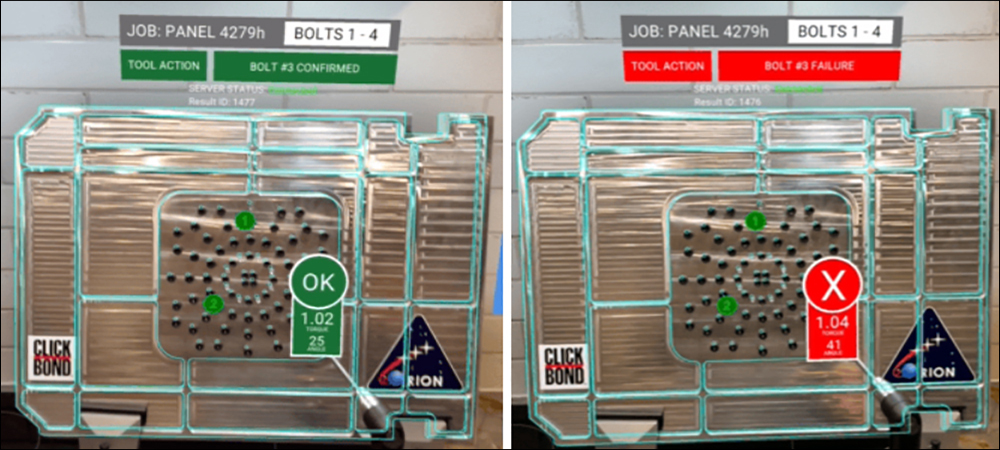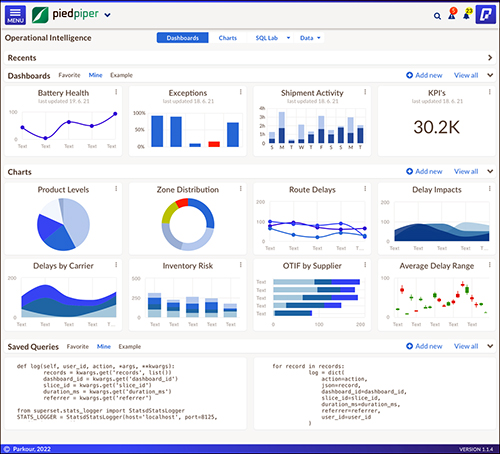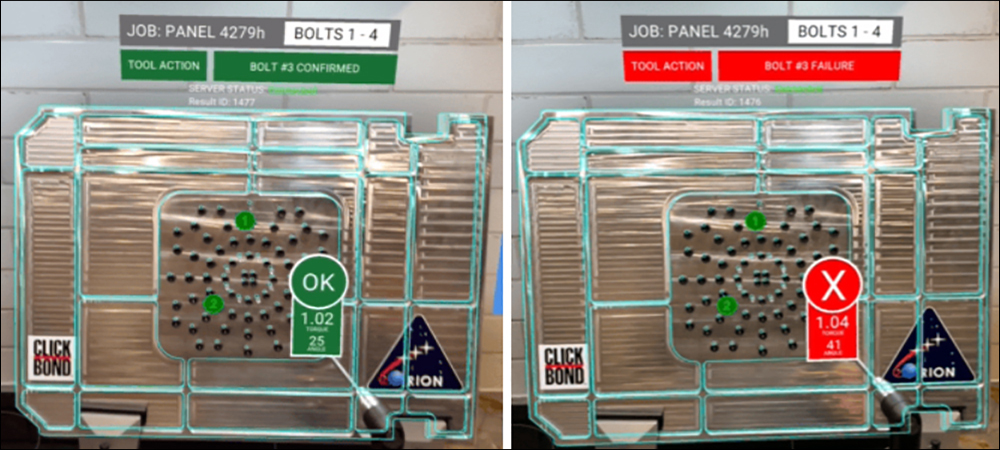- Scope AR, Litmus Automation Launch Augmented Reality IoT Platform
- Ligado Networks, Sony Connect Millions of IoT Devices via Satellite
- ParkourSC Expands Real-Time Supply Chain Platform with Digital Twins.
- Memfault, NXP Partner on IoT In-Field Device Monitoring
- Digital Twin Consortium Appoints XMPro Regional Branch Organizer
Presented here are recent news announcements in the radio frequency identification and Internet of Things industries.
Scope AR, Litmus Automation Launch Augmented Reality IoT Platform
Scope AR has announced the launch of WorkLink IoT, its platform service that enables real-time data connectivity within industrial environments for augmented reality (AR) experiences. The service is designed to enhance WorkLink, the company’s enterprise AR platform, with Internet of Things (IoT)-enabled devices and real-time data fabrics. WorkLink IoT resulted from a collaboration with Litmus Automation, which offers a scalable edge platform for Industrial IoT data connectivity. The partnership also involved fastener expertise from Click Bond, as well as smart tools from Atlas Copco for and 3D AR wearable devices, including Microsoft‘s Hololens 2.
The company predicts that WorkLink IoT will become “a critical component of the AR-enabled digital thread for manufacturing and field service use cases.” Real-time data from smart tools and an array of industrial edge devices can be aggregated into augmented reality work instructions. WorkLink IoT is intended to provide real-time data to technicians and systems of record throughout a physical product’s lifecycle.

Scope AR’s WorkLink IoT platform service
“Our customers are absolutely thrilled to integrate machine data into their AR work instructions,” said Scott Montgomerie, Scope AR’s CEO and founder, in a prepared statement. “Imagine measuring the torque of each fastening operation as you build a product, with instant feedback provided to the technician in augmented reality. That data can also be sent to any manufacturing or service systems of record in real time. This completely changes the quality control and compliance landscape for our customers, offering unprecedented traceability, insights and human error avoidance.”
“We are pleased to partner with Scope AR to provide access to all industrial data at the edge from any type of machine or tool,” said John Younes, Litmus’s cofounder and COO, in the statement. “Our technology allows WorkLink IoT to connect to any device in minutes, normalize the data for easy consumption, and integrate the data with the AR platform. Now, customers can focus on getting value out of their data and the AR solution rather than spending time solving operational complexity, since we’ve done that work.”
As Montgomerie explained in the statement, “Previously, customers were forced to hard-code their own data pathways or manage disparate systems in order to enable smart factory data into augmented reality experiences. This has limited production use cases at scale. Instead, we partnered with Litmus and built a system to allow any available edge data feed to be accessed from within our code-free AR environment, removing any compatibility or development inhibitors to scale.”
Ligado Networks, Sony Connect Millions of IoT Devices via Satellite
Ligado Networks has teamed up with Sony Semiconductor Israel to develop chipsets for Ligado’s 5G mobile satellite network for the IoT, to enable connectivity services throughout North America. Ligado’s 3GPP standards-based 5G satellite IoT network will support tens of millions of mobile devices powering machine-to-machine communications in the transportation, agriculture, utilities and energy sectors. The partnership is intended to provide enterprise customers with both standalone satellite and combined satellite and terrestrial connections.
“As a leader in developing IoT standards for mobile satellite networks, we are excited to work with Sony to advance new capabilities and serve the growing market for 5G mobile satellite connectivity anywhere in the U.S. and across North America,” said Sachin Chhibber, Ligado’s chief technology officer, in a prepared statement. “This satellite capability will also support our 5G mobile private network solution by enabling ubiquitous coverage and reliability, which are essential for critical infrastructure enterprises as they modernize operations.”
Sony will adapt 5G IoT technology and manufacture IoT chipsets compatible with Ligado’s L-band MSS spectrum, which 3GPP has standardized as band 255 for non-terrestrial networks. Ligado plans to deploy a 5G satellite IoT network to support mainstream devices using low-cost chipsets for satellite and terrestrial connectivity. The satellite offering, the company reports, adds extended coverage and network redundancy to its planned 5G mobile private network solution, enabling what the firm calls “always-on connectivity and coverage across an enterprise’s entire footprint.”
With the 22-meter (72-foot) reflector-based antenna of Ligado’s SkyTerra 1 satellite, the network will support real-time communication to the small modules and devices used for such applications as wide-area vehicle diagnostics, environmental monitoring, smart metering and messaging. Ligado and Sony expect the work to be completed in phases, with the goal of conducting initial technology trials by the end of this year.
“We are excited to support Ligado’s 5G mobile satellite network,” said Dima Feldman, Sony Semiconductor Israel’s VP of product management and marketing, in the statement. “The addition of satellite connectivity to our market-leading 5G IoT chipsets improves utility for critical communications customers and expands our market reach.”
ParkourSC Expands Real-Time Supply Chain Platform with Digital Twins

ParkourSC’s digital supply chain operations platform
ParkourSC has expanded its digital supply chain operations platform by offering intelligent digital twins designed for real-time supply chain operations across the extended enterprise. According to the company, the global supply chain is under great pressure, with disruptions resulting in shortages of product inputs, a reduced ability to maintain production capacity, backed-up ports and extended delivery times. Volatility has stretched lean supply chains to their limits and reduced profitability, ParkourSC notes, emphasizing the need for “agility, resilience and innovation.”
“Current market volatilities ratchet up the pressure on lean supply chains to remove barriers and improve resiliency,” said Mahesh Veerina, the company’s CEO, in a prepared statement. “Our real-time supply chain operations platform enables companies to digitize their supply chains, embed intelligence and automation to optimize operations, and increase on-time in-full delivery. With ParkourSC, organizations can move beyond visibility to drive innovation, competitive advantage, and growth through their supply chains.”
The firm reports that customers increasingly expect products customized to specific preferences, improved service and transparency, on-time delivery, and product quality and compliance. Manufacturers, meanwhile, struggle to overcome the data and organizational silos that prevent them from leveraging supply chains to deliver new products and services that can increase customer satisfaction and drive competitive advantage.
ParkourSC says it designed its platform to help manufacturers address these challenges and enable customers to deploy intelligent digital twins for the end-to-end supply chain; continuously align planning and execution by delivering ground-truth and predictive intelligence to planning applications; foster collaboration and automation across the extended enterprise by sharing digital twins and automating processes across the extended enterprise, including suppliers, partners, customers and other entities; and drive business innovation and growth by using the platform to adjust business models and deliver new products and services to customers.
Memfault, NXP Partner on IoT In-Field Device Monitoring
Memfault, a cloud-based connected device observability platform provider, is collaborating with NXP Semiconductors to give device manufacturers in-field device monitoring, iteration and updating capabilities for product development and device operation. IoT device manufacturers building products based on NXP microcontrollers (MCUs) will have access to Memfault’s device observability platform, the company reports, enabling them to establish a proactive development approach to root-cause and fix bugs before end users can detect them.
Memfault’s embedded device diagnostics platform is designed to address serviceability challenges via fleet observability, remote debugging and smart firmware over-the-air management, enabling support and product teams to have insights into embedded device performance from a single pane of glass in a cloud-based environment. Engineers building on NXP MCUs will have remote access to debugging information without requiring user interactions, device RMAs or onsite visits, while release managers can orchestrate complex OTA updates of firmware in an organized and controlled manner.
“Bringing Memfault into the NXP Partner program was an obvious choice, as they provide clear value to customers who are looking to deploy edge-connected products,” said Brendon Slade, NXP Semiconductors’ director of MCU tools and ecosystem for edge processing, in a prepared statement. “Memfault has made it easy to integrate their SDK into base projects for NXP devices and transfer diagnostics data to their cloud platform. This allows customers to save time and focus on building leading products rather than on triaging and troubleshooting.”
With this collaboration, embedded developers can deploy Memfault’s system on up to 100 NXP devices for free. By dropping the Memfault SDK into an MCUXpresso IDE project, NXP developers can integrate the SDK into their NXP-based IoT projects with just a few clicks. Memfault is compatible with low-power, secure NXP MCUs and all major connectivity protocols, including UWB, Wi-Fi, BT and CAN, the company reports, as well as with Zephyr RTOS and non-RTOS firmware projects.
“We know NXP’s customers are creating extraordinarily advanced devices, and we are excited to give them better insight and control over their devices in the field,” added François Baldassari, Memfault’s CEO, in the prepared statement. “NXP’s vision to build secure connections for a smarter world keeps them at the forefront of design and innovation and a great technology leader for Memfault’s core offerings.”
Digital Twin Consortium Appoints XMPro Regional Branch Organizer
The Digital Twin Consortium has named XMPro its regional branch organizer (RBO) for Australia and New Zealand. XMPro will facilitate and drive local engagements and activities with regional industry, government and academic institutions on behalf of the Consortium throughout those countries. RBOs drive awareness and adoption of digital twins, develop and implement use cases throughout the digital twin lifecycle, and conduct local Consortium events and joint promotional activities.
XMPro has been a longstanding contributor to the Digital Twin Consortium. With its presence in the region, the company says it can facilitate local activities for organizations interested in digital twin technologies. Its No-Code Application Development Platform helps mining, oil and gas, and manufacturing companies build digital twins to improve situational awareness and decision-making.
“With XMPRO as the RBO for Australia and New Zealand, we are already seeing multiple opportunities through their strong relationships across various industries and academia,” said Dan Isaacs, the Digital Twin Consortium’s CTO, in a prepared statement. “XMPro has an extensive and growing network of partners, companies and associations with local government, industry and academia to further the advancement of digital twin and enabling technologies.”
The Consortium recently celebrated its second anniversary. With more than 200 member organizations representing 36 countries, the group strives to foster awareness, adoption, interoperability and development of digital twin technologies. “The Digital Twin Consortium has been advocating for digital twins globally,” added Pieter van Schalkwyk, XMPro’s CEO, in the prepared statement. “We’re excited to be a catalyst for the conversations on a local level in Australia and New Zealand. We look forward to building an engaged community through regular in-person events throughout the region.”


